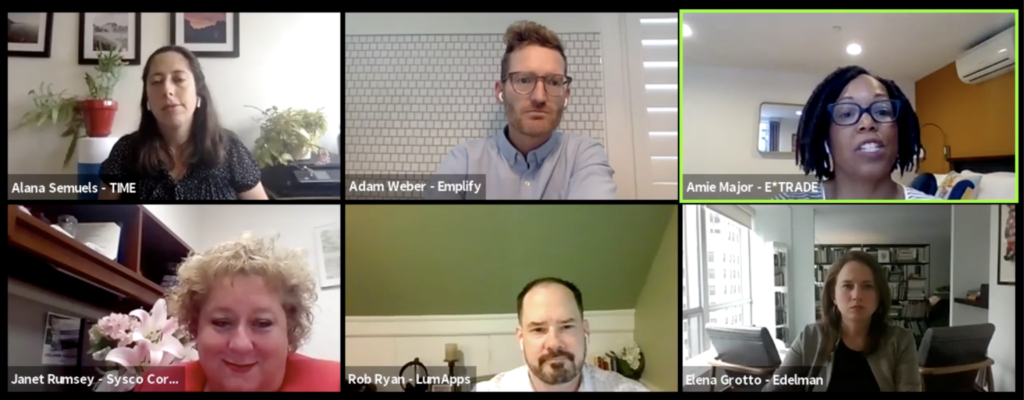How a Leader Brings Clarity to Benefits Offerings
“Benefits, perks, compensation–they’re all taken into account when job offers are made. That’s how you remain competitive. We don’t have to offer every single benefit that’s out there. We just have to offer the right ones.” This is according to Lenka Sloman, the managing director, and head of total rewards at global advertising firm GroupM.Sloman joined the company in September 2023, taking over the company’s benefits offerings and finding ways for GroupM to remain competitive for top ad talent. During the closing fireside chat at From Day One’s April virtual conference, I interviewed the total rewards leader about her strategy for getting the best return on investment for GroupM’s total rewards.Sloman’s challenge will be to balance market demands with individual needs.Tracking the Most Popular BenefitsThere is no limit to the size of benefits packages today. Not only are there innumerable vendors and platforms, the breadth of options is ever-widening.Sloman has been watching the market for the most popular benefits and perks. Right now, it’s all about family planning. GroupM enhanced its family-building benefits recently, adding features like egg freezing, donor services, adoption, paid time off, and parental leave. The company even added milk-shipping services, “so if a birthing parent goes back to work and is traveling, they can pump their milk and have it sent to their homes, so the baby can continue feeding,” said Sloman. It can also be used for surrogacy arrangements.“This is critically important for our employees,” she said. “We want to make sure our employees don’t have to worry about taking time off because they have to take care of a child–or whatever the case may be. If we get it right, they can concentrate on bonding with their newborns or adopted children, and it balances with their professional lives.”And she didn’t forget about those workers who don’t have kids at home. GroupM even offers dog-walking and pet-sitting services. “Pets are part of the family too,” she said.Competing for Talent With Exceptional Benefits PackagesSo, how does Sloman stay abreast of what’s going on in the benefits market?The talent acquisition team gathers information from job seekers about what they’re being offered elsewhere–and this provides helpful intel. But Sloman puts more stock into the data gathered by benefits consultants. “Understanding the benchmarks and getting guidance from our consultants sometimes has a more accurate description as to what our peers are doing. That’s what we base our decisions on. Really, it’s an art, not a science.”Lenka Sloman, right, was interviewed by journalist Emily McCrary-Ruiz-Esparza during the virtual fireside chat (photo by From Day One)Keeping up with what’s happening in the benefits workplace, learning to distinguish between must-haves and nice-to-haves, and annually reviewing GroupM’s utilization plan are the three steps she follows to make the company an employer of choice.When benefits are regularly refreshed and augmented, new hires will be interested and current ones are more likely to stay. But the annual review isn’t necessarily spring cleaning. “We don’t have a policy that says, if no one’s using it, we’re going to get rid of it. We will generally put it on a watch list to revisit it once a year to make sure the return on investment is there.”To keep ROI high, employees have to know what’s available so they can use it. Sloman is persistent in her comms strategy. She holds a weekly call with new hires to review their benefits and answer questions. Existing employees get their own call focused on a specific benefit, often selected for timeliness. These calls are heavily attended, she said. “In February, for example, we wanted to make sure everyone got their receipts for their FSA, so we dedicated time to remind employees.”Sloman keeps an eye on the market, careful to not fall into the trap of fads. Yet she’s also keen on individualization. Work-life balance looks different for every employee, and the way they want to achieve it will vary just as widely. To this end, Sloman likes to keep some perks as flexible as possible.“I think people-first culture and work-life balance right now are top priorities for employees. That’s something we haven’t had before,” she said. But that means something different to everyone. To some, flexible work isn’t an interesting benefit; they would rather have more time off to spend with their families. Others will prefer remote work. The point is that employees could pick and choose their work and benefits arrangements in a way that best fits them. That’s something they’ll likely stick around for.Emily McCrary-Ruiz-Esparza is a freelance journalist and From Day One contributing editor who writes about work, the job market, and women’s experiences in the workplace. Her work has appeared in the BBC, the Economist, the Washington Post, Quartz, Fast Company, and Digiday’s Worklife.





